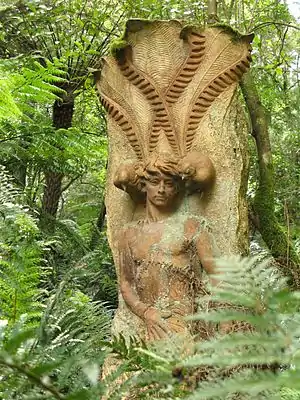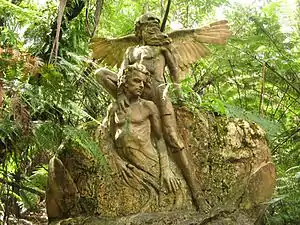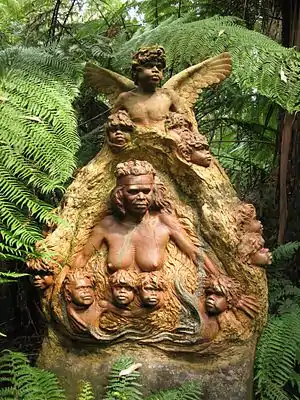William Ricketts
William Ricketts (1898–1993) was an Australian potter and sculptor of the arts and crafts movement.


Born in Richmond, Victoria, in 1898, William settled permanently in Mount Dandenong, Victoria, in 1934. Although not trained as a potter and never technically superior (his works, large and small, frequently exhibit cracking), the power of his vision of a modern Australia that embraces Aboriginal spirituality and respect for the natural world was his general message throughout his artworks.
His major works include the "Dromana" in the Seawinds Garden, Arthurs Seat, Victoria, and "Gun Brute" at the William Ricketts Sanctuary, Mount Dandenong, Victoria. Many smaller works are in the collection of the Powerhouse Museum in Sydney. Photographic records of his sculptures, particularly those from the sanctuaries of Pitchi Richi and Mount Dandenong, which have been vandalised, are held in the archives of Australia's libraries. Ricketts, never rich, supported himself through commissioned sales of his art and made pieces as gifts. These signed original small pieces are increasingly sought after for private collections.
From 1949 to 1960 he made frequent trips into Central Australia to live with Pitjantjatjara and Arrernte Aboriginal Australians, whose traditions and culture inspired his sculpture. He was not an Aboriginal by blood but considered himself adopted by the Pitjantjatjara nation. He left many of his central Australian works at Pitchi Richi near Alice Springs – a bird sanctuary run by his friend Leo Corbet – as he considered the landscape integral to these sculptures.
From 1912 to 1920 Ricketts developed skills in playing violin, crafting jewellery, and clay modelling. In 1934 he started his major artistic work, creating the sculpture park now named William Ricketts Sanctuary. He worked on this project until his death in 1993. In the 1970s, he spent two years in India, mostly at the Sri Aurobindo Ashram spiritual center in Puducherry, developing spiritual empathy with Indian people and knowledge of their philosophy.
To many, including academics such as Marcia Langdon, Bruno David and Mitchell Rolls, Rickets is considered a controversial figure with his beliefs and his sculptures steeped in racism, exploitation and primitivism. Rickets is viewed to have a white saviour complex and is quoted as believing he had been 'called to the defence of the aborigines and the continent' and that 'my creator worked through the Australian aborigine to get hold of me'. Ricket compares his own personal distress over the environment to the suffering of the Aboriginal People. His trips to central Australia were viewed as controversial and filled with misunderstanding and tensions with Ricket having incorrect preconceived notions of the roles of the Anangu people.
A further controversy is all the sculptures in the Dandenong rangers sanctuary are based in real aborigines from central Australia. One issue is displacement and treating a particular group of central Australian Aboriginal people as representative of all aboriginal people, with no independent integrity afforded to specific people and culture. Further there's the issue of how this park and these sculptures should be viewed by members of the aboriginal groups who they are members of and local aboriginal groups who's country the sculptures sit on, in accordance with traditional law and culture.
http://journals.sagepub.com/doi/abs/10.1177/13591835030082002
William Ricketts Sanctuary

Ricketts' major work is in the sculpture park that he named Potter's sanctuary, but which is now known as William Ricketts Sanctuary. In the 1960s the Government of Victoria bought the Sanctuary from Ricketts, and made it a public park. Ricketts lived there until his death in 1993.
